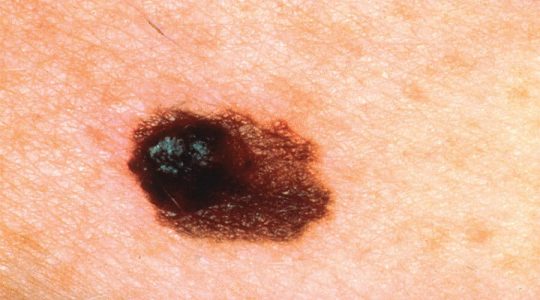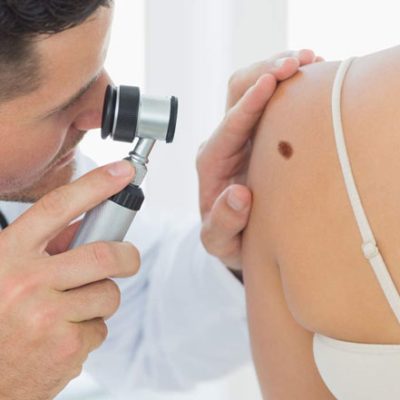Malignant Melanoma

Malignant Melanoma is a very serious skin cancer which can be fatal if left untreated
- Melanoma is a skin cancer which can develop in an existing mole or start as a new mole
- Those with multiple moles, abnormal moles and a strong family history of melanoma are at increased risk of developing melanoma
- Regular mole surveillance and skin checks is very important
- If left untreated, melanoma can potentially spread to other parts of the body
Malignant Melanoma
Melanoma is a skin cancer which develops in an existing mole or when new mole cells in the skin start to grow rapidly.
Although a less common type of skin cancer as compared to the more common basal and squamous cell cancers, malignant melanomas are very serious as they can grow quickly and spread to other parts of the body.
It is vital that they are diagnosed early as it can be potentially fatal if left untreated.
What causes Melanoma?
People with multiple moles, abnormal moles and a strong family history of melanoma are at increased risk of developing melanoma.
There are melanoma genes being identified, and the risk of melanoma can be passed from generation to generation in hereditary cases of melanoma.
Increasing age, fair skin which burns easily, and multiple sunburn episodes are also risk factors.
How is Melanoma diagnosed?
The appearance of a new mole, or any changes to an existing mole could be an indication of a melanoma. This is why it is so important to regularly check and monitor your moles for any changes. In most cases, melanomas are more than one colour and are irregular in shape, they can sometimes be itchy and bleed.
There are four main types of malignant melanoma.
- Superficial spreading melanoma– is the most common type of melanoma which will grow outwards initially, rather than downwards into the skin where they will not pose a problem. But if left untreated, they can grow down deep into the skin where they can spread to other parts of the body
- Nodular melanomas grow much quicker into the deeper layers of the skin. Their appearance is a changing dark and often bleeding lump on the skin. They often grow on normal skin, rather than an existing mole and commonly appear on the neck, head, chest and back.
- Lentigo maligna melanoma develop slowly over many years in sun-exposed areas such as the face and the arms. They may resemble sun spots, and are often found in older people. They will gradually grow bigger and deeper into the skin forming lumps.
- Acral lentiginous melanomas are very rare and appear on the hands or the feet, particularly around a nail.
How can Melanoma be prevented?
Melanoma is not always preventable, but following proper sun protection measures and avoiding sunburns can reduce the risk of melanoma.
Regularly checking and monitoring of moles for changes is vital to identify any changing moles, so that melanoma can be detected and treated as soon as possible.
How do I identify cancerous moles?
Regular skin checks and mole examination by the dermatologist, in addition to regular self checks are important to detect any rapidly changing or suspicious moles. Features of suspicious moles to look out for-
A Asymmetry – one half does not match the other half B Borders – the mole has uneven borders
C Colour – there is a variety of colours in the mole (brown, black, white, red) D Diameter – the mole grows larger than a pencil eraser (6mm) E Evolution – the mole evolves in size, shape, colour, elevation or there is a new feature
C Colour – there is a variety of colours in the mole (brown, black, white, red) D Diameter – the mole grows larger than a pencil eraser (6mm) E Evolution – the mole evolves in size, shape, colour, elevation or there is a new feature
A Asymmetry – one half does not match the other half B Borders – the mole has uneven borders
C Colour – there is a variety of colours in the mole (brown, black, white, red) D Diameter – the mole grows larger than a pencil eraser (6mm) E Evolution – the mole evolves in size, shape, colour, elevation or there is a new feature
If you notice any changes to your moles, our dermatologist will be able to quickly evaluate and diagnose so that treatment can be arranged promptly.
How can Melanoma be treated?
The main treatment for malignant melanoma is wide excision surgery to remove the lesion from the skin. If melanoma is diagnosed and treated early enough, surgery is usually successful.
If melanoma is not removed, the cancer cells can grow deeper into the layers of the skin. And once these cancers cells reach the blood or lymphatic system, they can travel to other parts of the body which can be potentially fatal.
Depending on how deep the melanoma has grown into the skin, subsequent lymph node biopsy and full body imaging may be necessary for cancer staging.
For melanoma which has spread to other organs (metastasis), medical oncology team will need to come onboard to discuss options of medical chemotherapy treatment.
DISCLAIMER:
The information written and published on this website is not intended to substitute the recommendations of a trained professional and does not replace a professional consultation.
It is advisable to undergo a formal consultation to help establish a relationship between the doctor and yourself, accurately determine your concerns/problems, and get the appropriate treatments for them.
It is also imperative to note that the contents of the website with respect to treatments, results and pricing can vary from individual to individual, and can only be accurately determined by the doctor upon diagnosis.
Do note that all medical treatments will only be administered upon proper consultation, with the requirement that patients be above 21 years of age to provide legal consent.
Skin Cancer
Meet your Dermatologist

Dr Tay Liang Kiat
Dermatologist
Dr Tay Liang Kiat is a fully accredited Dermatologist who specialises in skin cancers, Mohs micrographic surgery, dermatologic and nail surgery, aesthetic dermatology and laser procedures. With more than 20 years of clinical experience, he also manages other aspects of general ambulatory and inpatient dermatology, including eczema, psoriasis, acne, urticaria, hair loss, children skin issues and other complex medical dermatology. In addition, he has expertise in the use of the latest immunotherapy (biologics) treatment for severe eczema, psoriasis and urticaria.






